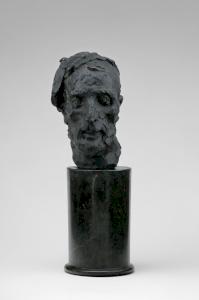Jacques Lipchitz (1891-1973)
Chaïm Jacob Lipchitz was born on August 2, 1891 at Druskieniki in Lithuania. He quickly discovered his talent for modeling. When he moved to Paris in October, 1909, at the age of 18, the administration registered him under the name Jacques Lipchitz, and he kept it. He was the student of Jean-Antoine Injalabert at the École des Beaux-Arts and then of Raoul Verlet at the Académie Julian, and little by little came to know the artists around Montparnasse, particularly those who frequented La Ruche. He became friends with Diego Rivera, Amedeo Modigliani, Max Jacob, and the cubist painters. In 1913, he began what he called his "proto-cubist" period, using simplified geometric forms. When the war was declared in 1914, he moved to Spain and showed in Madrid with Diego Rivera and Maria Blanchard. He returned to Paris in 1915 in a state of crisis and destroyed a number of his works. He then went to into an intensive creative phase. In 1916, he married the Russian poet Berthe Kitrosser, took over Brancusi's studio at 54 rue du Montparnasse, and signed a contract with the dealer Léonce Rosenberg. He spent several months with Juan Gris at Beaulieu-les-Loches in Touraine in 1918.
He had first solo show at the gallery l'Effort Moderne at the beginning of 1920, and Maurice Raynal published the first monograph on the sculptor. But this was also the year that he parted ways with Rosenberg, who had reservations about changes in his style and his move away from cubism. Lipchitz did several figurative portraits, including ones of Raymond Radiguet and Jean Cocteau. The beginning of the 1920s was a difficult time for him, though he did get commissions from Coco Channel. In 1922, thanks to the dealer Paul Guillaume, he met the American collector Albert C. Barnes, who bought eight sculptures from him and commissioned five bas-reliefs for his house in Pennsylvania. He became a naturalized French citizen in 1924 and moved the following year to Boulogne, into a house that he had designed and built for him by Le Corbusier. He began work on a series of Transparents, sculptures dominated by emptiness. Between 1925 and 1935, he participated in a number of exhibitions at the Jeanne Bucher gallery in Paris, at the Brummer gallery in New York, at the Salon des indépendants, and other venues and fulfilled various commissions, such as La Joie de Vivre (The Joy of Living) for the Noailles at Hyères and The Chant des Voyelles (The Song of the Vowels) for Madame de Mandrot's garden in the Var. In 1937, he was represented at the International Exhibition by his Prométhée étranglant le vautour (Prometheus Strangling the Vulture), which established his international reputation. The themes he embraced from then on were often allegorical, mythological, or biblical and addressed the universality of the human drama.
When war was declared in 1940, he first took refuge in Toulouse and then emigrated to the United States, establishing himself in New York. After the war, he separated from Berthe, who moved back to Boulogne. In 1948, he married the sculptor Yulla Halberstadt, and they had a daughter, Lolya Rachel. This period of happiness was translated into his work in the form of a series of sculptures on the theme of mother and child. In his New York studio, he began studies for the Vierge d'Assy (The Assy Virgin) for the church Notre-Dame-de-Toute-Grâce in Savoy. After a fire destroyed his studio, he took one in the Museum of Modern Art and then built a new studio near his home at Hastings-on-Hudson. He participated in the 26th Venice Biennale in 1952 with 22 sculptures in the French pavilion. From 1954 on, his work was the subject of a number of retrospectives across the world. Around 1955, he briefly broke with monumental sculpture and created a number of experimental pieces, letting himself be guided by the material itself in two series, "Semi-automatiques" and "A la limite du possible." He became a naturalized American citizen in 1958. In 1962, he discovered Italy, and spent all of his summers there, working on monumental sculptures in bronze and Carrara marble. He died in Capri on May 26, 1973 and is buried in Jerusalem.

